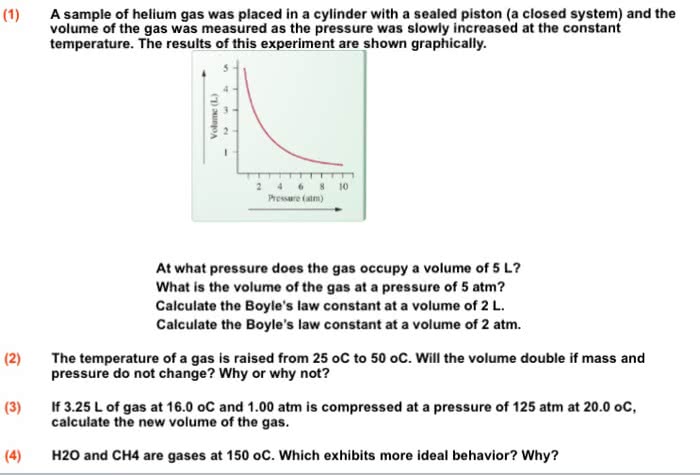In answering this set of nine questions, you are encouraged to draw a PV diagram, with P (pressure) on the y axis and V (volume) on the x axis. Plot the three points A, B, and C on this diagram.
Consider 3.00 liters of an ideal (monatomic) gas at a pressure of 31.0 atm and a temperature of 356 K. Call this state of the system A. Using the ideal gas law, calculate the number of moles of gas present in the system.
Number of moles, n = 3.19
The temperature of the system is reduced, keeping the volume constant at 3.00 liters, until the pressure in the system equals 16.0. Call this state of the system B. Calculate the temperature at this new state B in degrees K.
Temperature at state B = 184
Now the gas is allowed to expand at constant pressure (16.0 atm) until the temperature is again equal to 356 K. Call this state of the system C. Calculate the volume of the gas at state C.
Volume at state C = 5.81
Now calculate the work done on or by the system when the system moves back from state C to state A along the path CBA. Enter your answer in joules with the correct sign.
Work along the path CBA, w = 4.56E+3
Calculate the heat absorbed or liberated by the system when the system moves from state C to state B. Note that the molar heat capacity of an ideal gas under constant pressure is (5/2)R. Enter your answer in joules with the correct sign.
Heat along the path C to B, q = -1.14E+4
Using your results from the previous two questions, calculate the heat absorbed or liberated by the system as it moves from state B to state A. Enter your answer in joules with the correct sign.
Heat along the path B to A, q = 6.84E+3
What is the change in the internal energy of the system as the system travels down the isotherm from state A to state C?
Change in internal energy down the isotherm = 0.000
How much work is done by the system as the system travels down the isotherm from state A to state C? Enter your answer in joules with the correct sign.
Work down the isotherm, w = -6.23E+3
How much heat must be absorbed or liberated by the system as it moves down the isotherm from A to C? Enter your answer in joules with the correct sign.
Heat down the isotherm, q = 6.23E+3
In answering this set of nine questions, you are encouraged to draw a PV diagram, with P (pressure) on the y axis and V (volume) on the x axis. Plot the three points A, B, and C on this diagram.
Consider 3.00 liters of an ideal (monatomic) gas at a pressure of 31.0 atm and a temperature of 356 K. Call this state of the system A. Using the ideal gas law, calculate the number of moles of gas present in the system.
Number of moles, n = 3.19
The temperature of the system is reduced, keeping the volume constant at 3.00 liters, until the pressure in the system equals 16.0. Call this state of the system B. Calculate the temperature at this new state B in degrees K.
Temperature at state B = 184
Now the gas is allowed to expand at constant pressure (16.0 atm) until the temperature is again equal to 356 K. Call this state of the system C. Calculate the volume of the gas at state C.
Volume at state C = 5.81
Now calculate the work done on or by the system when the system moves back from state C to state A along the path CBA. Enter your answer in joules with the correct sign.
Work along the path CBA, w = 4.56E+3
Calculate the heat absorbed or liberated by the system when the system moves from state C to state B. Note that the molar heat capacity of an ideal gas under constant pressure is (5/2)R. Enter your answer in joules with the correct sign.
Heat along the path C to B, q = -1.14E+4
Using your results from the previous two questions, calculate the heat absorbed or liberated by the system as it moves from state B to state A. Enter your answer in joules with the correct sign.
Heat along the path B to A, q = 6.84E+3
What is the change in the internal energy of the system as the system travels down the isotherm from state A to state C?
Change in internal energy down the isotherm = 0.000
How much work is done by the system as the system travels down the isotherm from state A to state C? Enter your answer in joules with the correct sign.
Work down the isotherm, w = -6.23E+3
How much heat must be absorbed or liberated by the system as it moves down the isotherm from A to C? Enter your answer in joules with the correct sign.
Heat down the isotherm, q = 6.23E+3


